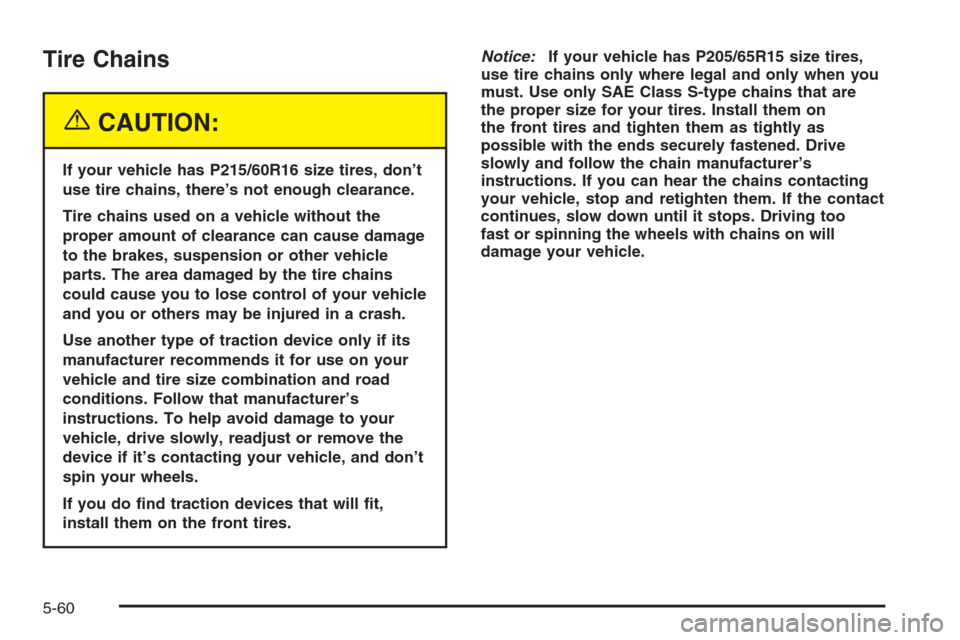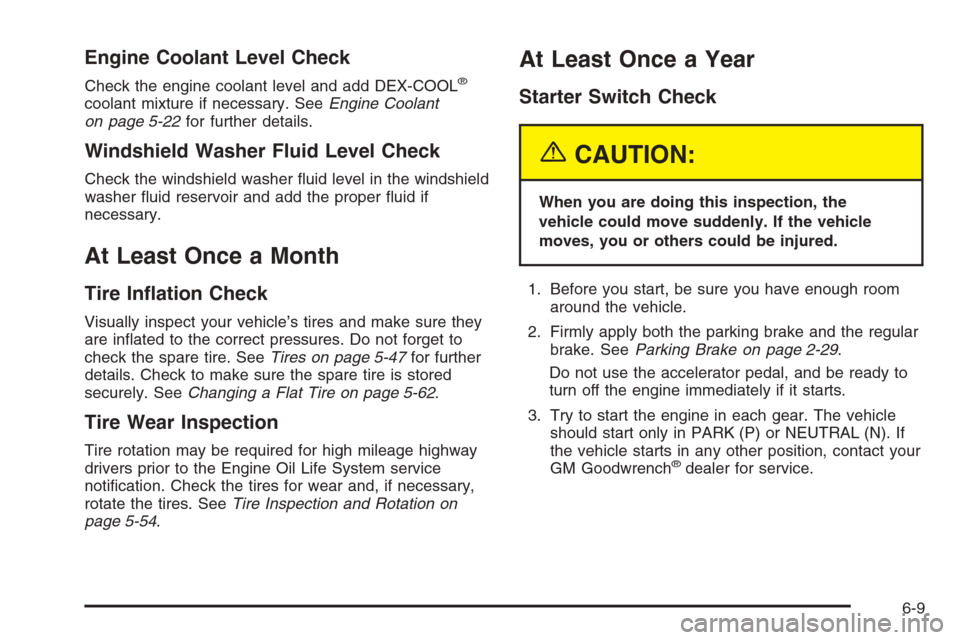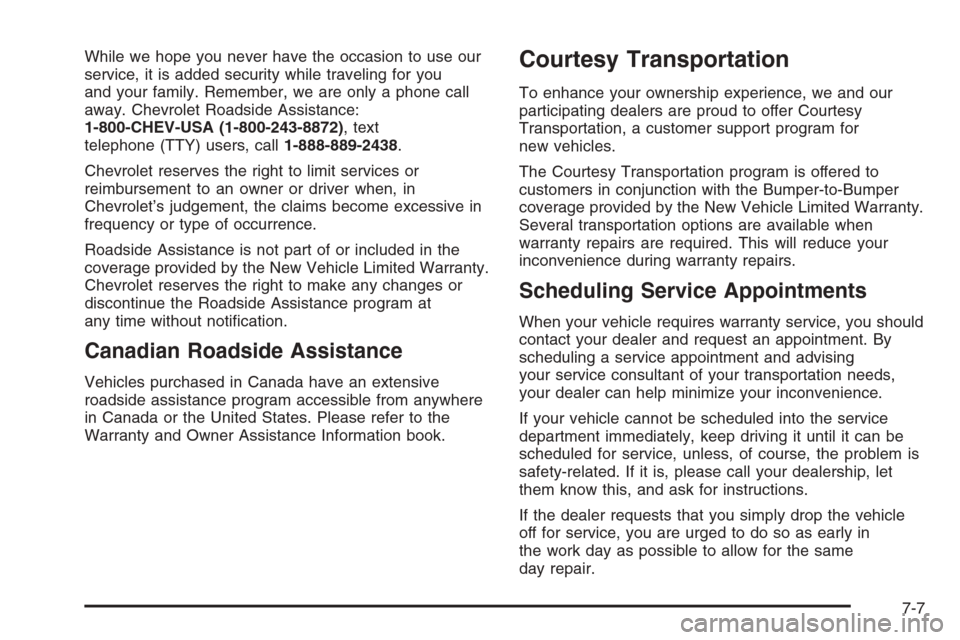Page 339 of 434

6. Connect the red positive (+) cable to the positive (+)
terminal of the dead battery.
7. Do not let the other end touch metal. Connect it to
the positive (+) terminal of the good battery. Use a
remote positive (+) terminal if the vehicle has one.8. Now connect the black negative (−) cable to the
negative (−) terminal of the good battery. Use a
remote negative (−) terminal if the vehicle has one.
Do not let the other end touch anything until the
next step. The other end of the negative (−) cable
does not go to the dead battery. It goes to a
heavy, unpainted metal engine part or to a remote
negative (−) terminal on the vehicle with the
dead battery.
9. Connect the other end of the negative (−) cable at
least 18 inches (45 cm) away from the dead battery,
but not near engine parts that move. The electrical
connection is just as good there, and the chance
of sparks getting back to the battery is much less.
If the security light �ashes, wait until the light
stops �ashing.
10. Now start the vehicle with the good battery and run
the engine for a while.
11. Try to start the vehicle that had the dead battery. If
it will not start after a few tries, it probably needs
service.
5-39
Page 344 of 434
2. Remove the
two fasteners
located on the inside
of the trunk at the
rear of the vehicle.
3. Pull back the trunk trim.
4. Remove the plastic wing nut.
5. Pull out the taillamp assembly and turn the bulb
socket one quarter turn counterclockwise.6. Pull the bulb to remove
it from the socket.
Replace the old bulb
with a new one.
7. Reverse the steps to attach the taillamp assembly
to the vehicle.
When securing the lamp assembly back into place,
align the assembly so that the trunk lid doesn’t
contact it.
5-44
Page 360 of 434

Tire Chains
{CAUTION:
If your vehicle has P215/60R16 size tires, don’t
use tire chains, there’s not enough clearance.
Tire chains used on a vehicle without the
proper amount of clearance can cause damage
to the brakes, suspension or other vehicle
parts. The area damaged by the tire chains
could cause you to lose control of your vehicle
and you or others may be injured in a crash.
Use another type of traction device only if its
manufacturer recommends it for use on your
vehicle and tire size combination and road
conditions. Follow that manufacturer’s
instructions. To help avoid damage to your
vehicle, drive slowly, readjust or remove the
device if it’s contacting your vehicle, and don’t
spin your wheels.
If you do �nd traction devices that will �t,
install them on the front tires.Notice:If your vehicle has P205/65R15 size tires,
use tire chains only where legal and only when you
must. Use only SAE Class S-type chains that are
the proper size for your tires. Install them on
the front tires and tighten them as tightly as
possible with the ends securely fastened. Drive
slowly and follow the chain manufacturer’s
instructions. If you can hear the chains contacting
your vehicle, stop and retighten them. If the contact
continues, slow down until it stops. Driving too
fast or spinning the wheels with chains on will
damage your vehicle.
5-60
Page 370 of 434
Storing a Flat or Spare Tire and
Tools
{CAUTION:
Storing a jack, a tire, or other equipment in the
passenger compartment of the vehicle could
cause injury. In a sudden stop or collision,
loose equipment could strike someone. Store
all these in the proper place.
For the sedan, store the �at tire and jack in the compact
tire compartment as follows:
1. Remove the center cap from the wheel.
2. Place the tire in the compartment, valve stem
down, with the bolt extending through the wheel
center hole.
3. Place the jack and wrench over the bolt, inside the
wheel.
4. Secure by tightening the larger wing nut onto
the bolt.A. Cover
B. Wing Nut
C. JackD. Flat Tire (Valve
Stem down)
E. Bolt Sedan
5-70
Page 371 of 434
For the MAXX, store the �at tire and jack in the compact
spare tire compartment as follows:
1. Remove the bolt extension (in the yellow sleeve)
from the jack.
2. Place the jack over the bolt (A) on the �oor making
sure it contacts the bolt as shown. Secure it with
the bracket and nut provided.3. With the valve stem up, place the tire on the
compartment �oor with the rear of the tire beneath
the trim panel. The tire may not lay completely
�at. Line up a wheel nut hole with the bolt.
4. With the yellow cap in place to prevent the wheel
from being scratched, screw the bolt extension
onto the bolt through the wheel nut hole.
5. Remove the plug from the center hole of the �oor
cover by pressing on the tabs on the bottom of the
cover. Remove the yellow cap from the bolt
extension.
6. Fold the rear �ap of the cover up and place the
cover on top of the wheel. The extension will
come through the center hole in the cover.
7. Secure the cover with the larger wing nut.
MAXX
5-71
Page 384 of 434
Instrument Panel Fuse Block
The instrument panel fuse block is located at on the lower front side of the console, on the passenger side of the
vehicle. To access the fuses, open the fuse panel door by pulling out.
To reinstall the door, insert the hooks at the front end �rst, then push the door into the console panel to secure it.
5-84
Page 401 of 434

Engine Coolant Level Check
Check the engine coolant level and add DEX-COOL®
coolant mixture if necessary. SeeEngine Coolant
on page 5-22for further details.
Windshield Washer Fluid Level Check
Check the windshield washer �uid level in the windshield
washer �uid reservoir and add the proper �uid if
necessary.
At Least Once a Month
Tire In�ation Check
Visually inspect your vehicle’s tires and make sure they
are in�ated to the correct pressures. Do not forget to
check the spare tire. SeeTires on page 5-47for further
details. Check to make sure the spare tire is stored
securely. SeeChanging a Flat Tire on page 5-62.
Tire Wear Inspection
Tire rotation may be required for high mileage highway
drivers prior to the Engine Oil Life System service
noti�cation. Check the tires for wear and, if necessary,
rotate the tires. SeeTire Inspection and Rotation on
page 5-54.
At Least Once a Year
Starter Switch Check
{CAUTION:
When you are doing this inspection, the
vehicle could move suddenly. If the vehicle
moves, you or others could be injured.
1. Before you start, be sure you have enough room
around the vehicle.
2. Firmly apply both the parking brake and the regular
brake. SeeParking Brake on page 2-29.
Do not use the accelerator pedal, and be ready to
turn off the engine immediately if it starts.
3. Try to start the engine in each gear. The vehicle
should start only in PARK (P) or NEUTRAL (N). If
the vehicle starts in any other position, contact your
GM Goodwrench
®dealer for service.
6-9
Page 415 of 434

While we hope you never have the occasion to use our
service, it is added security while traveling for you
and your family. Remember, we are only a phone call
away. Chevrolet Roadside Assistance:
1-800-CHEV-USA (1-800-243-8872), text
telephone (TTY) users, call1-888-889-2438.
Chevrolet reserves the right to limit services or
reimbursement to an owner or driver when, in
Chevrolet’s judgement, the claims become excessive in
frequency or type of occurrence.
Roadside Assistance is not part of or included in the
coverage provided by the New Vehicle Limited Warranty.
Chevrolet reserves the right to make any changes or
discontinue the Roadside Assistance program at
any time without noti�cation.
Canadian Roadside Assistance
Vehicles purchased in Canada have an extensive
roadside assistance program accessible from anywhere
in Canada or the United States. Please refer to the
Warranty and Owner Assistance Information book.
Courtesy Transportation
To enhance your ownership experience, we and our
participating dealers are proud to offer Courtesy
Transportation, a customer support program for
new vehicles.
The Courtesy Transportation program is offered to
customers in conjunction with the Bumper-to-Bumper
coverage provided by the New Vehicle Limited Warranty.
Several transportation options are available when
warranty repairs are required. This will reduce your
inconvenience during warranty repairs.
Scheduling Service Appointments
When your vehicle requires warranty service, you should
contact your dealer and request an appointment. By
scheduling a service appointment and advising
your service consultant of your transportation needs,
your dealer can help minimize your inconvenience.
If your vehicle cannot be scheduled into the service
department immediately, keep driving it until it can be
scheduled for service, unless, of course, the problem is
safety-related. If it is, please call your dealership, let
them know this, and ask for instructions.
If the dealer requests that you simply drop the vehicle
off for service, you are urged to do so as early in
the work day as possible to allow for the same
day repair.
7-7